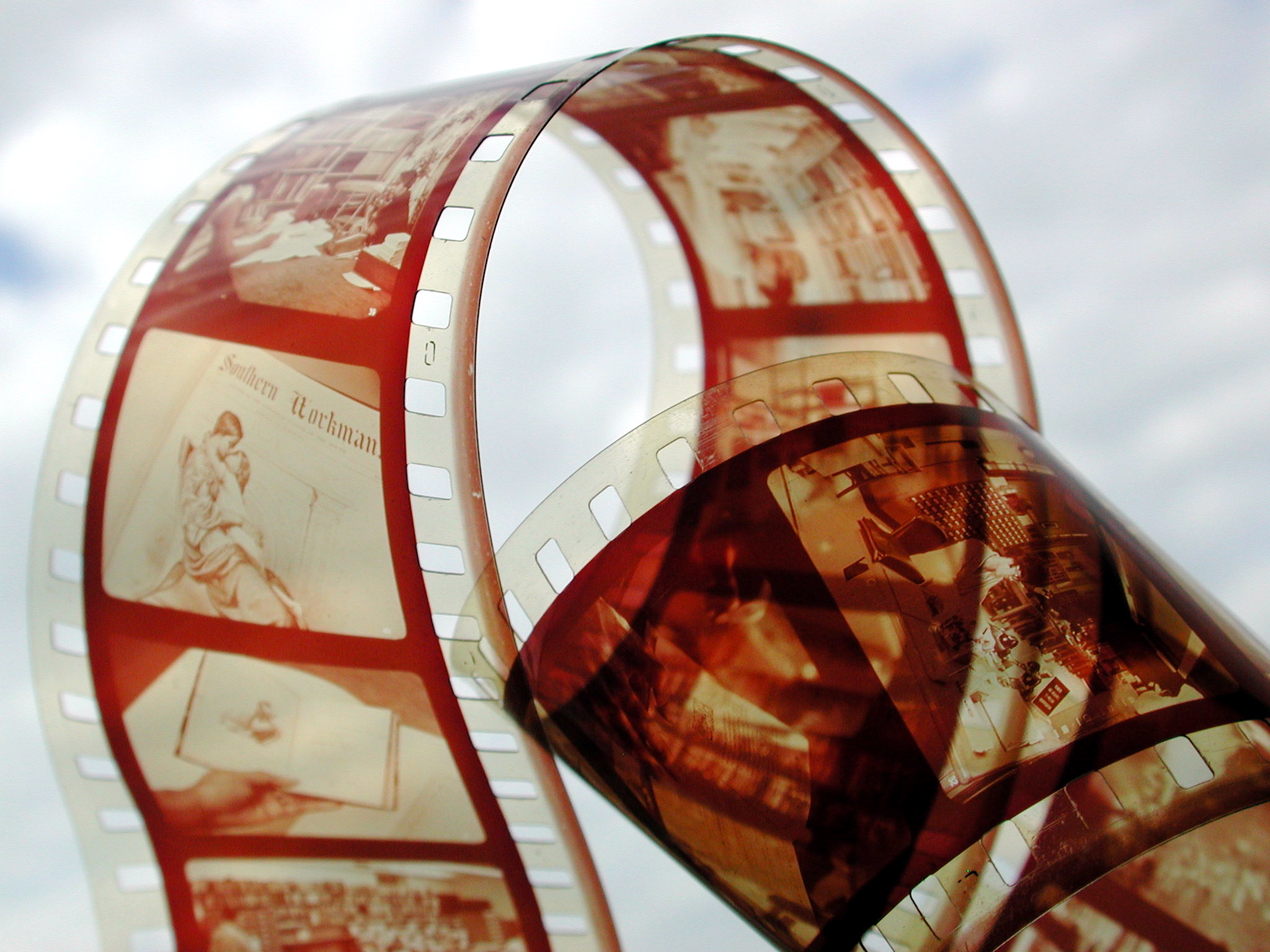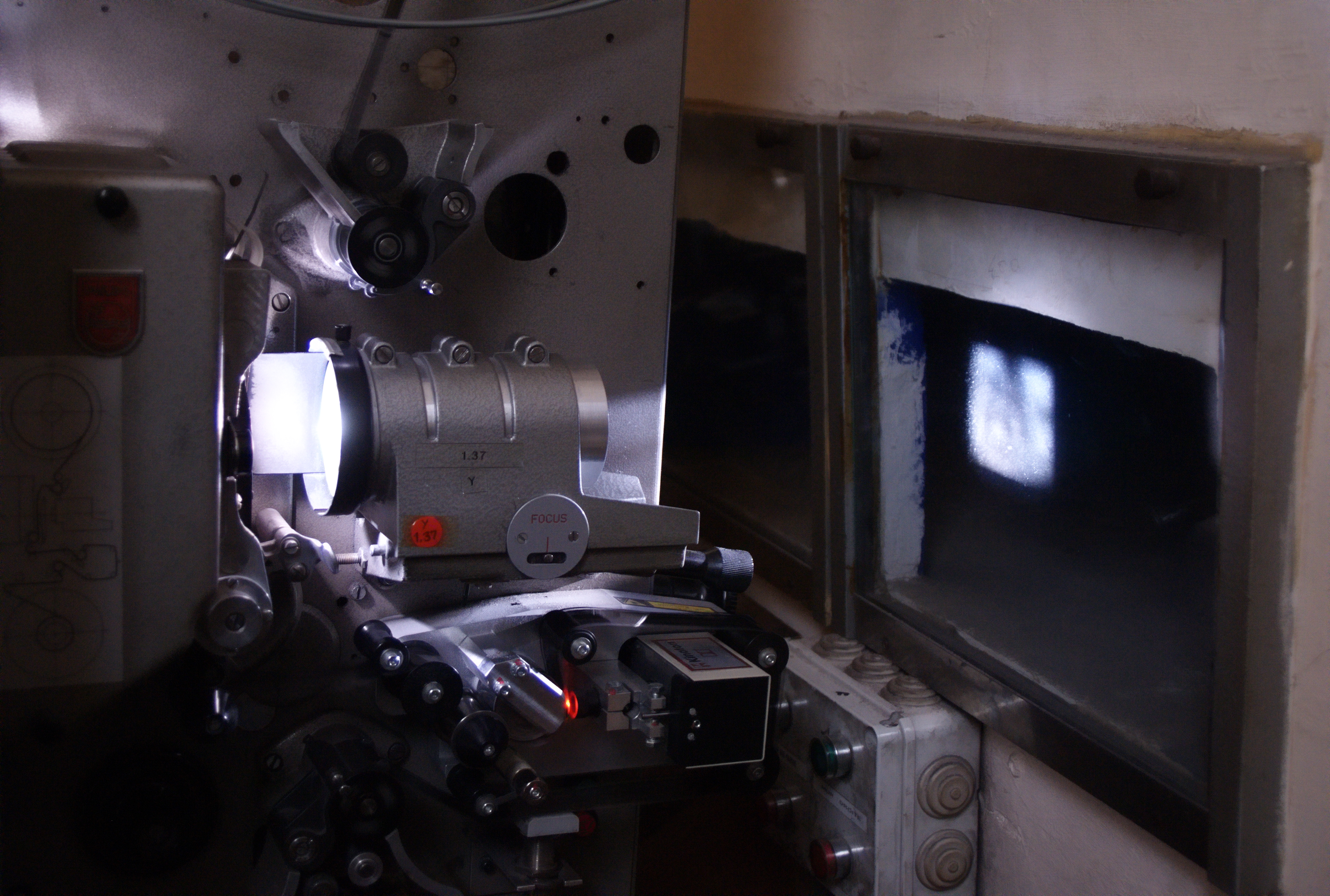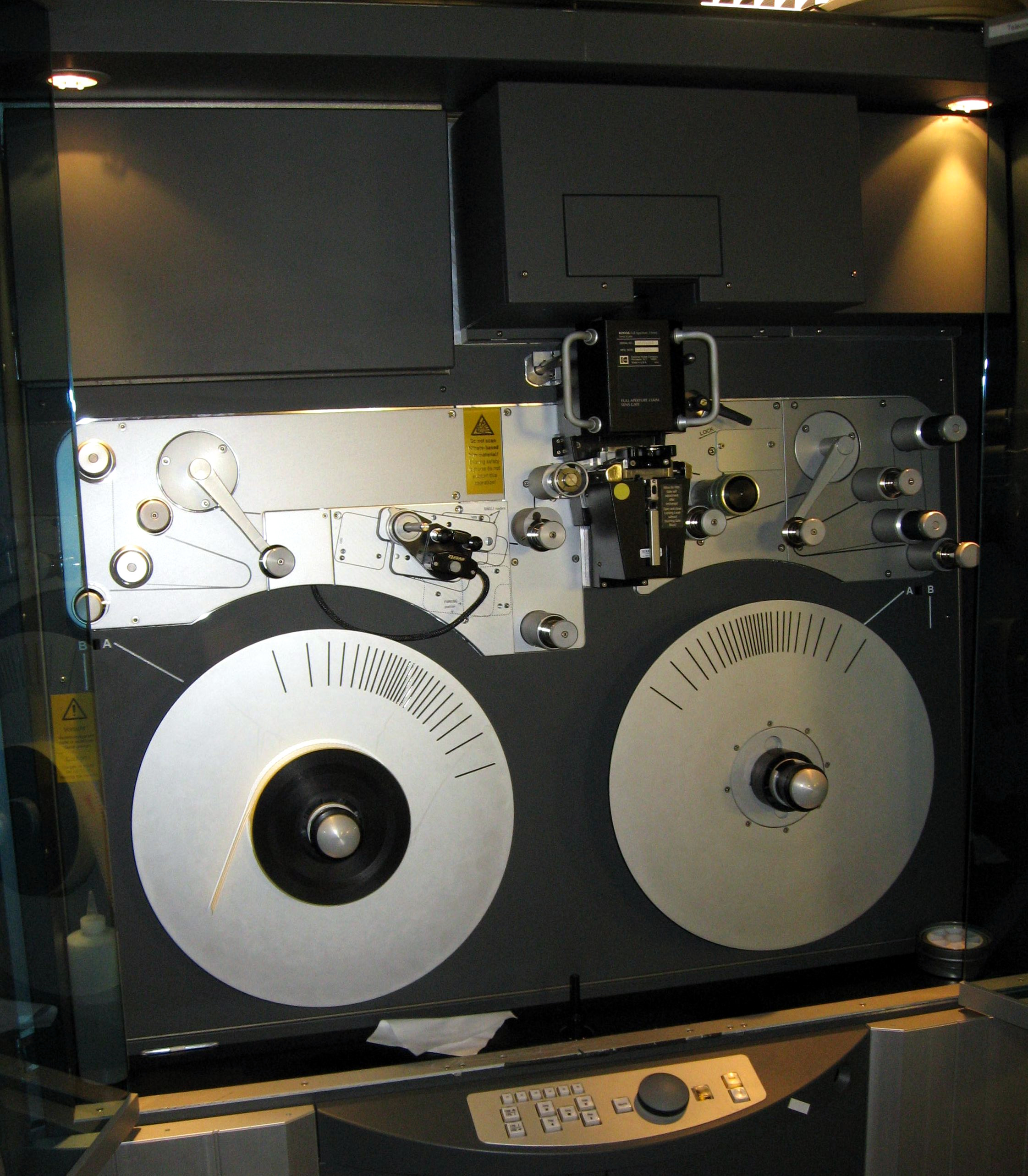|
Particle Transfer Roller
The particle transfer roller, often abbreviated to PTR, is a device for cleaning motion picture film. It consists of a cylindrical roller coated with urethane, over which the surface of the film passes. History The particle transfer roller was developed by Eastman Kodak and launched in 1989. It was intended to replace the organic solvents that were the main method of film cleaning before that point. Although their effectiveness is not usually considered sufficient for lab operations, where ultrasonic cleaning with a solvent solution remains the standard, the PTR sold widely for use in projection booths and transfer houses. Use At least two PTRs are needed in the film path – one for the base side and one for the emulsion side – though four are frequently used. A set of PTRs is frequently placed in the film paths of projectors, telecine machines, scanners and printers Printer may refer to: Technology * Printer (publishing), a person or a company * Printer (computing), a ... [...More Info...] [...Related Items...] OR: [Wikipedia] [Google] [Baidu] |
Film Stock
Film stock is an analog medium that is used for recording motion pictures or animation. It is recorded on by a movie camera, developed, edited, and projected onto a screen using a movie projector. It is a strip or sheet of transparent plastic film base coated on one side with a gelatin emulsion containing microscopically small light-sensitive silver halide crystals. The sizes and other characteristics of the crystals determine the sensitivity, contrast and resolution of the film.Karlheinz Keller et al. "Photography" in Ullmann's Encyclopedia of Industrial Chemistry, 2005, Wiley-VCH, Weinheim. The emulsion will gradually darken if left exposed to light, but the process is too slow and incomplete to be of any practical use. Instead, a very short exposure to the image formed by a camera lens is used to produce only a very slight chemical change, proportional to the amount of light absorbed by each crystal. This creates an invisible latent image in the emulsion, which can ... [...More Info...] [...Related Items...] OR: [Wikipedia] [Google] [Baidu] |
Ethyl Carbamate
Ethyl carbamate (also called urethane) is an organic compound with the formula CH3CH2OC(O)NH2. It is an ester of carbamic acid and a white solid. Despite its name, it is not a component of polyurethanes. Because it is a carcinogen, it is rarely used, but naturally forms in low quantities in many types of fermented foods and drinks. Synthesis It is produced industrially by heating urea and ethyl alcohol. It arise also by the action of ammonia on ethyl chloroformate. Uses Biomedical applications Ethyl carbamate has been used as an antineoplastic agent and for other medicinal purposes, but this application ended after it was discovered to be carcinogenic in 1943. However, Japanese usage in medical injections continued and from 1950 to 1975 an estimated 100 million 2 ml ampules of 7-to-15% solutions of ethyl carbamate were injected into patients as a co-solvent in water for dissolving water-insoluble analgesics used for post-operation pain. These doses were estimated to b ... [...More Info...] [...Related Items...] OR: [Wikipedia] [Google] [Baidu] |
Eastman Kodak
The Eastman Kodak Company (referred to simply as Kodak ) is an American public company that produces various products related to its historic basis in analogue photography. The company is headquartered in Rochester, New York, and is incorporated in New Jersey. Kodak provides packaging, functional printing, graphic communications, and professional services for businesses around the world. Its main business segments are Print Systems, Enterprise Inkjet Systems, Micro 3D Printing and Packaging, Software and Solutions, and Consumer and Film. It is best known for photographic film products. Kodak was founded by George Eastman and Henry A. Strong on May 23, 1892. During most of the 20th century, Kodak held a dominant position in photographic film. The company's ubiquity was such that its " Kodak moment" tagline entered the common lexicon to describe a personal event that deserved to be recorded for posterity. Kodak began to struggle financially in the late 1990s, as a result of the ... [...More Info...] [...Related Items...] OR: [Wikipedia] [Google] [Baidu] |
Organic Solvent
A solvent (s) (from the Latin '' solvō'', "loosen, untie, solve") is a substance that dissolves a solute, resulting in a solution. A solvent is usually a liquid but can also be a solid, a gas, or a supercritical fluid. Water is a solvent for polar molecules and the most common solvent used by living things; all the ions and proteins in a cell are dissolved in water within the cell. The quantity of solute that can dissolve in a specific volume of solvent varies with temperature. Major uses of solvents are in paints, paint removers, inks, and dry cleaning. Specific uses for organic solvents are in dry cleaning (e.g. tetrachloroethylene); as paint thinners (toluene, turpentine); as nail polish removers and solvents of glue (acetone, methyl acetate, ethyl acetate); in spot removers (hexane, petrol ether); in detergents ( citrus terpenes); and in perfumes (ethanol). Solvents find various applications in chemical, pharmaceutical, oil, and gas industries, including in chemical synt ... [...More Info...] [...Related Items...] OR: [Wikipedia] [Google] [Baidu] |
Film Laboratory
A film laboratory is a commercial service enterprise and technical facility for the film industry where specialists develop, print, and conform film material for classical film production and distribution which is based on film material, such as negative and positive, black and white and color, on different film formats: 65-70mm, 35mm, 28mm, 16mm, 9.5mm, 8mm. The film laboratory managers can charge by the footage or by time used while in lab. History In the early days of motion pictures, films were processed by winding on flat racks and then dipping in tanks of solution. As films became longer, such methods proved to be too cumbersome. Processes Exposed motion picture film will be processed according to exact chemical prescriptions at measured temperature as well as over measured time. After processing there is an original, the camera or picture original, in most cases a negative. From it a first sample is exposed on a motion-picture film printer. Again after processin ... [...More Info...] [...Related Items...] OR: [Wikipedia] [Google] [Baidu] |
Ultrasonic Film Cleaner
Ultrasound is sound waves with frequencies higher than the upper audible limit of human hearing. Ultrasound is not different from "normal" (audible) sound in its physical properties, except that humans cannot hear it. This limit varies from person to person and is approximately 20 kilohertz (20,000 hertz) in healthy young adults. Ultrasound devices operate with frequencies from 20 kHz up to several gigahertz. Ultrasound is used in many different fields. Ultrasonic devices are used to detect objects and measure distances. Ultrasound imaging or sonography is often used in medicine. In the nondestructive testing of products and structures, ultrasound is used to detect invisible flaws. Industrially, ultrasound is used for cleaning, mixing, and accelerating chemical processes. Animals such as bats and porpoises use ultrasound for locating prey and obstacles. History Acoustics, the science of sound, starts as far back as Pythagoras in the 6th century BC, who wrot ... [...More Info...] [...Related Items...] OR: [Wikipedia] [Google] [Baidu] |
Movie Projector
A movie projector is an optics, opto-mechanics, mechanical device for displaying Film, motion picture film by projecting it onto a movie screen, screen. Most of the optical and mechanical elements, except for the illumination and sound devices, are present in movie cameras. Modern movie projectors are specially built video projectors. (see also digital cinema) Many projectors are specific to a particular film gauge and not all movie projectors are film projectors since the use of film is required. Predecessors The main precursor to the movie projector was the magic lantern. In its most common setup it had a concave mirror behind a light source to help direct as much light as possible through a painted glass picture slide and a lens, out of the lantern onto a screen. Simple mechanics to have the painted images moving were probably implemented since Christiaan Huygens introduced the apparatus around 1659. Initially candles and oil lamps were used, but other light sources, such ... [...More Info...] [...Related Items...] OR: [Wikipedia] [Google] [Baidu] |
Telecine
Telecine ( or ) is the process of transferring film into video and is performed in a color suite. The term is also used to refer to the equipment used in the post-production process. Telecine enables a motion picture, captured originally on film stock, to be viewed with standard video equipment, such as television sets, video cassette recorders (VCR), DVD, Blu-ray Disc or computers. Initially, this allowed television broadcasters to produce programs using film, usually 16mm stock, but transmit them in the same format, and quality, as other forms of television production. Furthermore, telecine allows film producers, television producers and film distributors working in the film industry to release their productions on video and allows producers to use video production equipment to complete their filmmaking projects. Within the film industry, it is also referred to as a TK, because TC is already used to designate timecode. Motion picture film scanners are similar to telecines. ... [...More Info...] [...Related Items...] OR: [Wikipedia] [Google] [Baidu] |
Motion Picture Film Scanner
A motion picture film scanner is a device used in digital filmmaking to scan original film for storage as high-resolution digital intermediate files. A film scanner scans original film stock: negative or positive print or reversal/IP. Units may scan gauges from 8 mm to 70 mm (8 mm, Super 8, 9.5 mm, 16 mm, Super 16, 35 mm, Super 35, 65 mm and 70 mm) with very high resolution scanning at 2K, 4K, 8K, or 16K resolutions. (2K is approximately 2048×1080 pixels and 4K is approximately 4096×2160 pixels). Some models of film scanner are intermittent pull-down film scanners which scan each frame individually, locked down in a pin-registered film gate, taking roughly a second per frame. Continuous-scan film scanners, where the film frames are scanned as the film is continuously moved past the imaging pick up device, are typically evolved from earlier telecine mechanisms, and can act as such at lower resolutions. The scanner scans ... [...More Info...] [...Related Items...] OR: [Wikipedia] [Google] [Baidu] |
Optical Printer
An optical printer is a device consisting of one or more film projectors mechanically linked to a movie camera. It allows filmmakers to re-photograph one or more strips of film. The optical printer is used for making special effects for motion pictures, or for copying and restoring film material. Common optical effects include fade outs and fade ins, dissolves, slow motion, fast motion, and matte work. More complicated work can involve dozens of elements, all combined into a single scene. History The first commercially available, although not mass produced, optical printer appeared in 1927 and was called the Depue & Vance Daylight Optical Printer. It was mainly used to reduce standard prints to 16mm and allowed for operation without a darkroom except from loading the positive film magazine. In 1918, the cinematographer Carl Gregory came upon a printer made by G. J. Badgley of New York, designed to produce copies of a standard film using domestic size film stock. Realizing the p ... [...More Info...] [...Related Items...] OR: [Wikipedia] [Google] [Baidu] |
National Film And Sound Archive
The National Film and Sound Archive of Australia (NFSA), known as ScreenSound Australia from 1999 to 2004, is Australia's audiovisual archive, responsible for developing, preserving, maintaining, promoting and providing access to a national collection of film, television, sound, radio, video games, new media, and related documents and artefacts. The collection ranges from works created in the late nineteenth century when the recorded sound and film industries were in their infancy, to those made in the present day. The NFSA collection first started as the National Historical Film and Speaking Record Library (within the then Commonwealth National Library) in 1935, becoming an independent cultural organisation in 1984. On 3 October, Prime Minister Bob Hawke officially opened the NFSA's headquarters in Canberra. History of the organisation The work of the Archive can be officially dated to the establishment of the National Historical Film and Speaking Record Library (part of t ... [...More Info...] [...Related Items...] OR: [Wikipedia] [Google] [Baidu] |
Film And Video Technology
A film also called a movie, motion picture, moving picture, picture, photoplay or (slang) flick is a work of visual art that simulates experiences and otherwise communicates ideas, stories, perceptions, feelings, beauty, or atmosphere through the use of moving images. These images are generally accompanied by sound and, more rarely, other sensory stimulations. The word "cinema", short for cinematography, is often used to refer to filmmaking and the film industry, and to the art form that is the result of it. Recording and transmission of film The moving images of a film are created by photographing actual scenes with a motion-picture camera, by photographing drawings or miniature models using traditional animation techniques, by means of CGI and computer animation, or by a combination of some or all of these techniques, and other visual effects. Before the introduction of digital production, series of still images were recorded on a strip of chemically sensitize ... [...More Info...] [...Related Items...] OR: [Wikipedia] [Google] [Baidu] |








